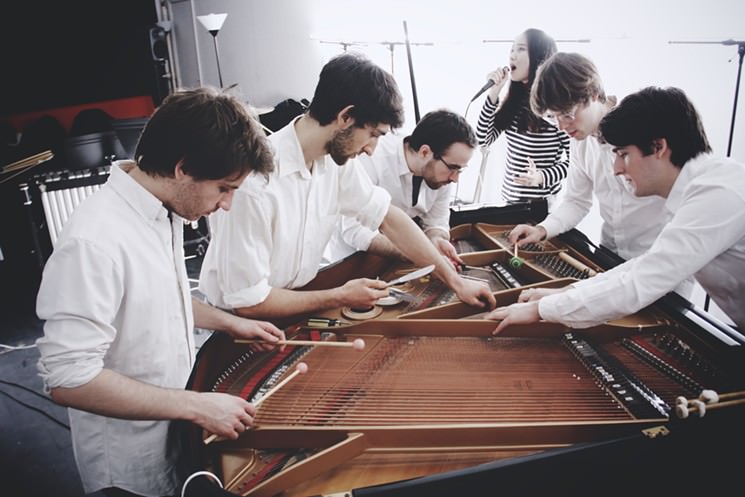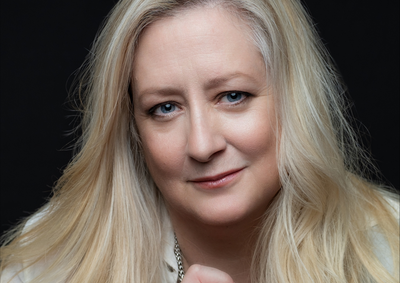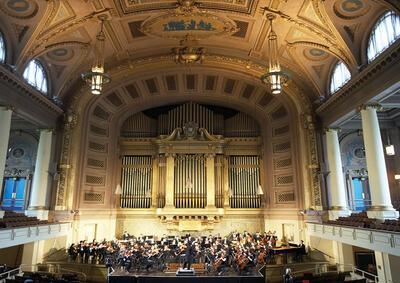Vivid Sections: Invisible Anatomy Take a Bold Stance on Classical Performance
It begins much like any show at any small club in New York. Under glowing lights, the musicians, in casual clothing, take up their instruments. They smile at one another with a relaxed warmth; they acknowledge their audience. They begin to play.
It sounds like indie rock, familiar and pleasant. The singer's voice is sweet and smooth. And then you notice: She's not singing words, but making sounds that mimic actual lyrics. What started as a melody line is lasting too long and becoming strange. One of the players moves his body in a way that looks painful, then does something to his instrument that makes it sound like it's breaking. It is otherworldly and uncanny. It is definitely not a rock concert.
This is Invisible Anatomy, a contemporary classical chamber ensemble. On January 28 they premiere a new evening-length work, Dissections, at National Sawdust, Brooklyn's recently opened hub for experimental music. Like the venue, Invisible Anatomy aim to break down the barrier between pop and so-called New Music — and they want it to be fun.
"The notion [that] you need to suffer through New Music isn't something we're interested in," explains pianist Dan Schlosberg, one of the seven composers who together constitute Invisible Anatomy. "We are trying to have a more direct relationship with our audience."
‘We talked early on about what a band does that a chamber ensemble could do better.’
Although the group is now New York–based, it began in New Haven with its members' studies at the Yale School of Music. In the composition program there, students personally select which classmates perform their pieces; the musicians who would become Invisible Anatomy found themselves choosing to play together often. With several of them eyeing graduation, the ensemble formed in 2014 so that they could continue performing together. In so doing they joined New York's vibrant tradition of classical experimentation — and found themselves among like-minded outfits, such as Wet Ink Ensemble and Bang on a Can, revitalizing the genre.
At first, Invisible Anatomy mostly knew what they didn't want to do. "A normal concert of New Music is often a grab bag of unrelated pieces" by different composers, explains Schlosberg. The players wear all black, the lighting is overhead and glaring, and the fourth wall might as well be solid steel. Warmth, humor, and narrative are absent. "[You end up] pretending that just playing beautiful music creates an exciting experience," Schlosberg says. Invisible Anatomy believe that this dogmatism turns many listeners away from contemporary classical, and those are precisely the people whose ears the ensemble aims to win back.
Guitarist Brendon Randall-Myers had played in bands before turning to New Music, and his input led Invisible Anatomy to draw on the model of the former. "We talked early on about what a band does that a chamber ensemble could do better, especially the fact that a band cultivates a relationship over a long period of time," says Randall-Myers. "Bands are saying something true about themselves, whereas classical is letting someone else" — the composer — "speak for you. This is an opportunity to do both those things."
In operating this way, the members of Invisible Anatomy have all become intimately familiar with one another's discrete personal style; they can thus devote rehearsal time to finesse and expression, rather than trying to determine just what the composer or conductor is asking each player to do.
Each of their seasons is, in its way, an album: Last year's Body Parts was the first. Dissections, meanwhile, is a suite of interconnected pieces, one from each member, exploring what Randall-Myers calls "intimacy as a physical discomfort," the notion that there is a threshold beyond which closeness ceases to be inviting and instead becomes unbearable. "When you're trying to get to know someone, you have to overcome that. It's a very active process," he explains. "It's not quite violence, but it's a lot of energy expenditure." In Dissections, instruments serve as proxy for that invasion, and Invisible Anatomy hope to bust open the relationship between player and piece, between performer and audience.






